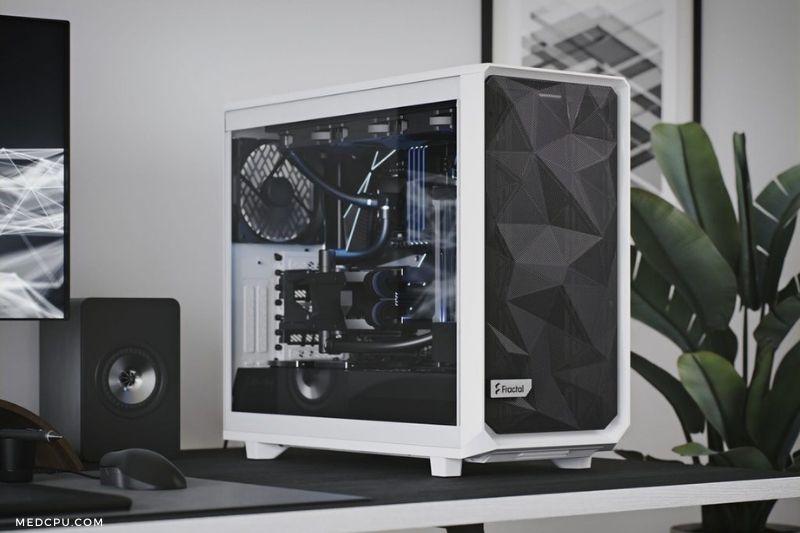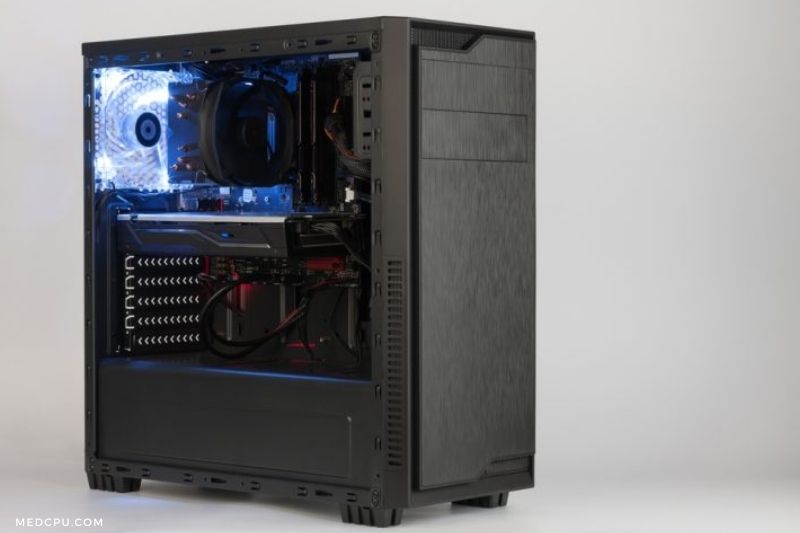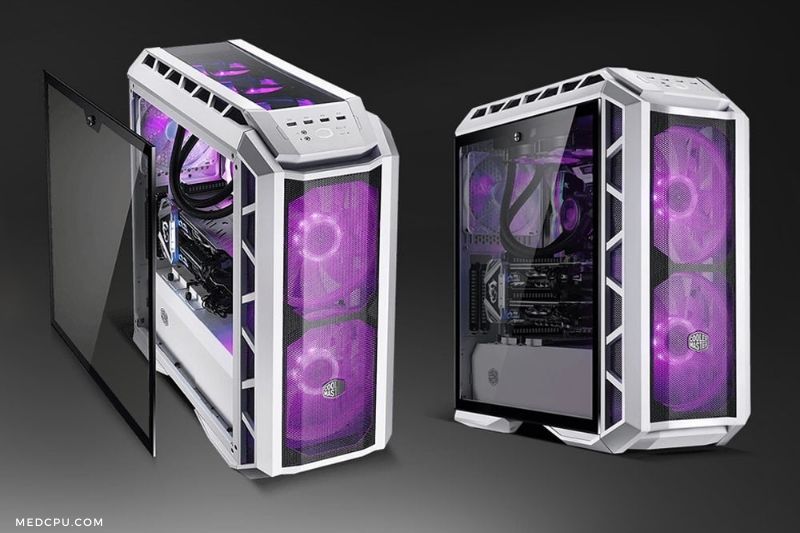When looking for a new PC, you’ll likely come across two types of desktop computers: Mid Tower vs Full Tower. The names of these two types indicate their size difference, and each has its own benefits and drawbacks.
In this article, MedCPU will compare these types of cases to help you choose the ideal case size for your next build.
About the Mid Tower

This mid-tower case is widely used. It can hold ATX motherboards, GPUs, and expansion bays of 2 to 3, 6 to 8, respectively. It can also be used with 2 to 3 standard-size motherboards.
Pros
- Can have up to six fans, as mentioned previously. Because there is a smaller chamber, dirt and dust can be easily managed. Because the air flows through a smaller area, it reaches every bit of dirt and poop.
- It can be carried around and stored in small spaces. It is small enough to be used by many people. This is the main advantage for mid-tower users.
- This is the best option for digital gamers. They can choose from a variety of slotting and GPU options. Recent games require two GPUs and six PCI-E slots.
Cons
- The installations were a good choice for digital gamers. However, the small water cooling system can heat the system to 90 degrees Celsius. This is a problem that will eventually become a problem.
- Another problem is with installing purposes. Because there is not much breathing space, the repair work can be costly and time-consuming. It can also cause damage to the internal hardware.
About Full Tower

Full Tower cases are the largest of all models. They are the most suitable for housing different types of computer hardware, such as drive bays and other slots like PCI slots.
It also provides space for water cooling and 12 fans to ensure a steady airflow.
Pros
- You can easily integrate the all-in-one or customized liquid cooling without making any additional changes. Because of water’s high specific heat capacity, the preinstalled water cooler system is more efficient than air cooling systems. This is another benefit for the computer system.
- The case is designed to provide ample space for installing video cards. This extra space allows for proper cable channeling, which makes the cooling process easier.
- For ample inward space, any faulty or static cables can be easily repaired. You can easily track down the exact point to repair by following the connections.
- Because of the large amount of space, hardware can be easily removed from the tower case. The full tower case is recommended for those who require frequent installation and significant expansion of their PC.
- There are 12 fans total in the tower case. The fans come in different sizes and positions to help circulate cold air currents and keep the computer’s performance at its best. This allows it to run faster and has a higher clock rate.
Cons
- It is a large structure that is difficult to move and bulky. This is the main reason the tower case has been largely ignored and not used.
- Air current circulation is affected by the large space. The central area receives more air than the corners. These areas create heat spots that make it challenging to work in. Eventually, 6-8 fans will stop you from operating.
- It’s more expensive due to its high functionality and large slots of rooms. However, it is cost-effective if you want to invest for a longer period and hold a job.
Comparison of the full tower and mid-tower PC cases

Size of the case
The largest difference between the two is the size of the PC’s case. You would assume that this means that there are more parts than you can fit in the case.
This is true. However, there are a few things to consider when choosing the right case size. This is where the rest comes in.
Let’s look at some things you should consider when choosing the right size for your next building.
Internal Space
Mid-tower cases have a higher internal volume than full tower cases. Most mid-tower cases are fine for most users. Modern mid-tower case designs are more efficient than ever. They can be wired well and have a great internal design.
Although full tower cases have more interior space, this does not mean that you will have better cable management or better airflow. There is no difference in airflow between full-tower and mid-tower housings.
A compact mid-tower chassis like the Lian Li Lancool 215 can provide some of the best airflows. A full tower case may be best for you if your E-ATX motherboard is large with tons of storage drives and a custom loop.
Motherboard Compatibility
This has been explained in the table before. But let’s review the differences to make sure. They usually support ATX MOBOs and Mini-ITX on mid towers. E-ATX support is possible. However, this is a rare occurrence.
Full towers will likely offer more options. These will support Mini-ITX and Micro-ATX motherboards. There’s no need to be timid about anything.
Expansion Slots & Drive Bays
You’ll find expansion slots in the mid towers, 7-9, and full towers, with 7-8. This is just an estimate. You might come across exceptions. Other than that, the average number of drive bays for mid towers is 5-10, and full towers are 10-15.
Fan Mounts and Water Cooling
Mid towers have fewer fan mounting options and fewer water cooling options than full towers. Mid towers will not have more than 6-9 fan mounting spots, whereas full towers may have 10-15. Are you going to need all that airflow goodness?! It’s up to you.
Both cases can be equipped with water-cooling options. Both cases should allow for AIO coolers to be installed. Full towers are best if you’re looking for custom loops.
Cable Management
This isn’t really about a full tower vs. a mid-tower thing. Each case will have its cable management facility. Full towers can be expensive and have a high price tag. They generally include rubber gromets and sufficient spacing behind the motherboard tray.
Mid towers may not offer the same level of service, however. It is best to examine the case in person.
Usage and price
Mid towers are cheaper and better suited to casual gaming or home use. These towers can also be used for office purposes. This is an excellent option for people who have a tight budget.
Full towers excel where mid towers fall short. Full towers are for serious gamers, PC enthusiasts, and hardcore gamers. These Pro grade cases do come at a higher price tag. They can be worth the extra expense.
What is the best time to buy a full tower?
- Multiple motherboards support and with 3 or 4 GPU’s is a desire.
- Support required for several hard drives
- Modular customization
- Water loops customized
- This PC case combines performance and convenience.
What is the best time to buy a mid-tower?
- Configuration 1 or 2. GPU configurations compatible with ATX motherboards
- Who have a tight budget or who are casual Desktop users
- You have limited space to play this case
- Are you focusing more on ventilation and airflow?
Read also How To Make A Gaming Setup: https://medcpu.com/how-to-make-a-gaming-setup/
FAQs
Is it possible to fit an ATX motherboard into a mid-tower?
Yes, in most cases. Although an ATX motherboard will fit most mid-tower PC cases, it will likely be limited in size.
Before you buy a case, make sure to check the specifications by downloading a copy. This will save you the hassle of returning your case to get a better replacement.
How do PC cases and their size affects cooling?
It’s much easier to keep a bigger case cool than a smaller one. Like we discussed, more fans provide better airflow.
It is also easier to keep the components cooler if they are further apart.
This applies to all drives. A larger motherboard allows for a greater distance between CPU coolers and chipset heatsinks.
There is also space between the components and the interior of the case. An increase in the gap can mean more air volume at any one time.
This allows cooling fans to have plenty of time to replace the air before the heat builds up between the components.
It is less likely than any other components or cables can block airflow within the case.
Are Mid-Towers suitable for gaming?
Absolutely. A Full Tower case is best if you are only interested in gaming. A Mid Tower case with a fan configuration and a multi-slot GPU is your best option.
A Mid Tower case is also great for liquid cooling components to overclock.
Conclusion
The choice depends mainly on the budget, available space in the room or in a desk setup, and whether you need a side window in the case. Full towers are better if you want to install high-end graphics cards or really deep radiators, or both.
Otherwise, unless you have a very limited budget, go for a mid-tower case. While not crucial, mid-towers are usually less noisy than full towers. When you do decide to go for a bigger case, make sure it’s compatible with your hardware.
Video:

Eyal Ephrat serves as the co-founder and CEO of medCPU.com, where technology is making significant strides in the field of medicine. Through his experience in purchasing PC and laptop equipment and various other tech products, Eyal Ephrat contributes valuable insights to medCPU’s mission.
